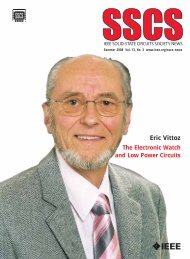The Impact of Dennard's Scaling Theory - IEEE
The Impact of Dennard's Scaling Theory - IEEE
The Impact of Dennard's Scaling Theory - IEEE
- TAGS
- scaling
- www.ieee.org
Create successful ePaper yourself
Turn your PDF publications into a flip-book with our unique Google optimized e-Paper software.
PEOPLE<br />
approach to IP ownership:<br />
MARCO receives a non-exclusive<br />
royalty-free license to all<br />
foreground IP and reasonable<br />
assurance that any critical background<br />
IP will be licensed for a<br />
reasonable royalty. Giving more<br />
authority to the Provost’s <strong>of</strong>fice<br />
to negotiate IP agreements<br />
should help the current situation.<br />
To be competitive globally,<br />
US companies now need<br />
university research results and<br />
the best interests <strong>of</strong> the country<br />
are served when this happens.<br />
Q. What are the new hot areas that<br />
for the next decade?<br />
A. Electronics and more specifically<br />
ICs have been the principal driver<br />
<strong>of</strong> the most important economic<br />
event <strong>of</strong> the past half century, the<br />
information revolution. My view <strong>of</strong><br />
the critical reason for the unprecedented<br />
impact <strong>of</strong> the IC is that it<br />
represents a fusion <strong>of</strong> the topdown<br />
and bottom-up approaches<br />
to microelectronics that has now<br />
evolved to become nanoelectronics.<br />
<strong>Scaling</strong> is our common term for<br />
the top-down approach. <strong>The</strong> bottom-up<br />
approach is epitomized by<br />
the self-assembled single crystal silicon<br />
ingot from which (now<br />
300mm) silicon wafers are sliced,<br />
each yielding several hundred<br />
chips each now containing several<br />
billion transistors.<br />
Of course Moore’s Law will<br />
cease, perhaps in a 10-20 year timeframe.<br />
But my crystal ball suggests<br />
IC manufacturing will be important<br />
for more than double that number<br />
<strong>of</strong> years. <strong>The</strong> “vacuum tube-to-transistor<br />
like” breakthrough that is<br />
needed to replace ICs will require a<br />
much more elegant and still<br />
unknown fusion <strong>of</strong> top-down nanotechnology<br />
in the sub-10nm range<br />
with self-assembled bottom-up nanotechnology<br />
probably rooted in<br />
biochemical science.<br />
Meindl accepted his award with<br />
these comments about technology.<br />
Early 21st century microchips are<br />
<strong>The</strong> first Editor, James Meindl, then <strong>of</strong> the US Army Electronics<br />
Command had to be very diligent in his search for both adequate<br />
quantity and quality <strong>of</strong> papers for his first issues.<br />
From the beginning, a decision was made that a major source <strong>of</strong><br />
papers for the JSSC should be the full-length versions <strong>of</strong> papers first<br />
presented at the ISSCC. However, this aspect took time. Many <strong>of</strong> the<br />
conference speakers at the ISSCC were not accustomed to publishing<br />
in refereed scholarly publications. After the vigorous refereeing and<br />
selection process for paper presentation at the ISSCC, it was necessary<br />
to work rather carefully with prospective authors to encourage<br />
them for further effort to achieve the results for adequate publication<br />
in a major journal <strong>of</strong> the <strong>IEEE</strong>.<br />
Dr. Meindl, as the first Editor made significant contributions, not<br />
only in working with the authors to publish their good contributions<br />
in spite <strong>of</strong> the press <strong>of</strong> their dealing on a daily basis with the exploding<br />
technology <strong>of</strong> solid-state circuits and devices. In addition he set<br />
the tone for the Journal <strong>of</strong> Solid-State Circuits. In short order he was<br />
able to achieve a high standard <strong>of</strong> quality and was able to establish<br />
a pattern <strong>of</strong> publishing major ISSCC presentations as regular title<br />
papers…<br />
From “<strong>The</strong> Origin <strong>of</strong> the Journal, the Council and the Conference<br />
<strong>of</strong> Solid-State Circuits” by Donald O. Pederson, JSSC, April 1984<br />
a marvelous consequence <strong>of</strong> a<br />
“fusion <strong>of</strong> the top-down and bottom-up<br />
approaches to nanotechnololgy.”<br />
Top-down nanotechnology<br />
has been used to pattern and<br />
produce multibillion transistor chips<br />
with minimum feature sizes now<br />
beyond 50 nm. Bottom-up nanotechnology<br />
has been used to produce<br />
self-assembled single crystal<br />
ingots <strong>of</strong> silicon that are sliced to<br />
provide 300 mm diameter wafers for<br />
microchip manufacturing. One<br />
broad prospective is that to advance<br />
beyond the ultimate limits <strong>of</strong> CMOS<br />
integrated electronics will require an<br />
elegant fusion <strong>of</strong> top-down and bottom-up<br />
nanotechnology enabled by<br />
future discoveries and inventions in<br />
both physical and biological science<br />
and engineering as pr<strong>of</strong>ound as the<br />
mid-20th century inventions <strong>of</strong> the<br />
transistor and the integrated circuit.<br />
Carbon nanotube and graphene<br />
nanoribbon technologies represent<br />
primitive examples <strong>of</strong> efforts to<br />
achieve such a fusion.<br />
About James Meindl<br />
Early in his career, Dr. Meindl<br />
developed micropower integrated<br />
circuits for portable military equip-<br />
ment at the U.S. Army Electronics<br />
Laboratory in Fort Monmouth, New<br />
Jersey. He then joined Stanford<br />
University in Palo Alto, California,<br />
where he developed low-power<br />
integrated circuits and sensors for a<br />
portable electronic reading aid for<br />
the blind, miniature wireless radio<br />
telemetry systems for biomedical<br />
research, and non-invasive ultrasonic<br />
imaging and blood-flow<br />
measurement systems. Dr. Meindl<br />
was the founding director <strong>of</strong> the<br />
Integrated Circuits Laboratory and<br />
a founding co-director <strong>of</strong> the Center<br />
for Integrated Systems at Stanford.<br />
<strong>The</strong> latter was a model for<br />
university and industry cooperative<br />
research in microelectronics.<br />
From 1986 to 1993, Dr. Meindl<br />
was senior vice president for academic<br />
affairs and provost <strong>of</strong> Rensselaer<br />
Polytechnic Institute in Troy,<br />
New York. In this role he was<br />
responsible for all teaching and<br />
research.<br />
He joined Georgia Tech in 1993<br />
as director <strong>of</strong> its Microelectronic<br />
Research Center. In 1998, he<br />
became the founding director <strong>of</strong><br />
the Interconnect Focus Center,<br />
where he led a team <strong>of</strong> more than<br />
52 <strong>IEEE</strong> SSCS NEWSLETTER Winter 2007




